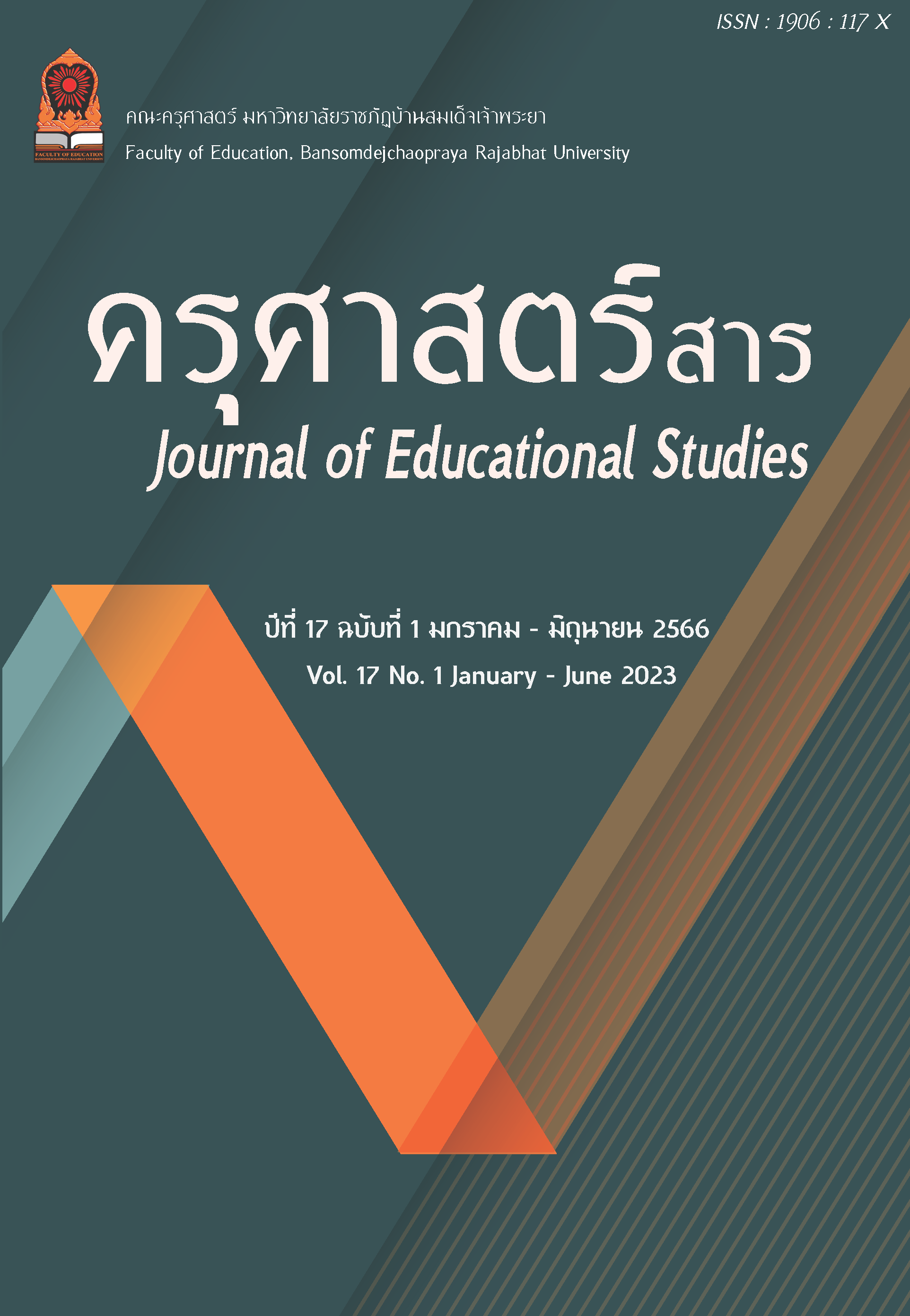Effect of Learning Activities According to Flipped Classroom Approach on Mathematics Achievement of Matthayom Suksa 3 Students
Keywords:
learning activities, flipped classroom, traditional learning, achievementAbstract
The objectives of this research were to 1) compare the mathematics learning
achievement on the graph of a quadratic function before and after participating in flipped
classroom activities, 2) compare the mathematics learning achievement of the group
participating in the flipped classroom activities on the graph of quadratic functions with
the group participating in the traditional learning activities, and 3) measure the students’
satisfaction with the flipped classroom activities.
The sample population consisted of Matthayom Sueksa 3 students at the
Demonstration School of Ramkhamhaeng University (Secondary Level) during the first
semester of the academic year 2021. The samples were obtained by cluster random
sampling from a total of eight classrooms, giving two sample rooms – one for experimental
group and the other one for control group, with 35 students each. The experimental group
participated in flipped classroom activities and the latter participated in traditional learning
activities. The research instruments consisted of (1) flipped classroom lesson plans and
traditional lesson plans, (2) an achievement test, and (3) a questionnaire to measure their
satisfaction with the flipped classroom activities. Data were analyzed using descriptive
statistics (mean scores and standard deviations), as well as inferential statistics t - test for
independent.
The results were as follows:
1) Mathematics learning achievement on graphs of quadratic functions of students
participating in flipped classroom activities was higher with the statistical significance level
of .05
2) Mathematics learning achievement on graphs of quadratic functions of students
participating in flipped classroom activities was higher than students participating in
traditional learning activities with the statistical significance level of .05
3) The students expressed a high level of satisfaction with the flipped classroom
activities ( X = 4.24, S.D. = 0.90)
Downloads
References
ถนอมพร เลาหจรัสแสง. (2557). ทักษะแห่งศตวรรษที่ 21 . เชียงใหม่ : มหาวิทยาลัยเชียงใหม่.
บุญชม ศรีสะอาด. (2545). การวิจัยเบื้องต้น (พิมพ์ครั้งที่ 7). กรุงเทพมหานคร: สำนักพิมพ์สุวีริยาสาส์น.
ไพฑูรย์ สินลารัตน์. (2557). เติบโตตามศักยภาพสู่ศตวรรษที่21 ของการศึกษาไทย. กรุงเทพฯ:
โรงพิมพ์แห่งจุฬาลงกรณ์มหาวิทยาลัย.
ภมรเมษย์ เลาหวิรุฬห์กุล. (2561). ผลการจัดกิจกรรมการการเรียนรู้ด้วยรูปแบบการเรียนรู้ห้องเรียน กลับด้านที่มีต่อผลสัมฤทธิ์ทางการเรียนและความสามารถในการสื่อสารทางคณิตศาสตร์ของนักเรียนชั้นมัธยมศึกษาปีที่ 3. วารสารสังคมศาสตร์และศิลปะศาสตร์มหาวิทยาลัย เกษตรศาสตร์,18(2),1-11
ยุภาพร ด้วงโต้ด. (2562). การจัดการเรียนรู้โดยใช้ห้องเรียนกลับด้าน เพื่อพัฒนาผลสัมฤทธิ์ทางการเรียน
รายวิชาคณิตศาสตร์ สาหรับนักเรียนชั้นมัธยมศึกษาปีที่ 3. วารสาร Veridian E Journal ฯ
สาขามนุษยศาสตร์ สังคมศาสตร์ และศิลปะ, มหาวิทยาลัยศิลปากร, 19(2) , 341-357
วิจารณ์ พานิช. (2556). วิถีการสร้างการเรียนรู้เพื่อศิษย์ในศตวรรษที่ 21. กรุงเทพฯ: มูลนิธิสดศรีสฤษดิ์วงศ์.
สำนักงานคณะกรรมการการศึกษาขั้นพื้นฐาน. (2560). ตัวชี้วัดและสาระการเรียนรู้แกนกลางกลุ่ม
สาระการเรียนรู้คณิตศาสตร์ (ฉบับปรับปรุง พ.ศ. 2560) ตามหลักสูตรแกนกลางการศึกษา ขั้นพื้นฐาน พุทธศักราช 2551. กรุงเทพฯ: โรงพิมพ์ชุมนุมสหกรณ์การเกษตรแห่งประเทศไทย จำกัด.
สุกัลยา นิลกระยา. (2557). การพัฒนาสื่อการสอนมัลติมีเดียบนเครือข่ายไร้สาย m-learning เรื่อง
ตรรกศาสตร์ โดยผ่านกระบวนการเรียนรู้แบบห้องเรียนกลับด้านเพื่อส่งเสริมการนำตนเอง.
วิทยานิพนธ์ . กรุงเทพฯ : บัณฑิตวิทยาลัย มหาวิทยาลัยเทคโนโลยีพระจอมเกล้าธนบุรี.
สุรศักดิ์ ปาเฮ. (2556). ห้องเรียกลับด้าน : ห้องเรียนมิติใหม่ในศตวรรษที่ 21 . สืบค้นจาก
http://phd.mbuisc.ac.th/academic/flippedped% 20classroom2.pdf.
สุภาพร สุดบนิด. (2557). เปรียบเทียบความรับผิดชอบต่อการเรียน เจตคติต่อการเรียนและผลสัมฤทธิ์
ทางการเรียน วิชาวิทยาศาสตร์ของนักเรียนชั้นมัธยมศึกษาปีที่ 1 ที่ได้รับการจัดกิจกรรมการ
เรียนรู้ตามแนวคิดห้องเรียนกลับทาง และการจัดกิจกรรมการเรียนรู้แบบปกติ. (วิทยานิพนธ์
กศ.ม. (วิจัยและประเมินผลการศึกษา). มหาวิทยาลัยมหาสารคาม, มหาสารคาม.
อรุณี วิริยะจิตรา และคณะ. (2555) .เหลียวหลังแลหน้าการสอนภาษาอังกฤษ. กรุงเทพฯ: หน้าต่างสู่โลกกว้าง.
อุบลวรรณ ปัญนะ. (2557). ผลการจัดกิจกรรมการเรียนรู้แบบใช้ปัญหาเป็นฐานร่วมกับเทคนิคห้องเรียน
กลับทาง ที่มีต่อความสามารถในการแก้ปัญหาทางคณิตศาสตร์. วารสารสังคมศาสตร์วิชาการ.
มหาวิทยาลัยราชภัฎเชียงราย,10(2),218-233.
Feledichuk, D. and Wong, A. (2015). The Impact of a Flipped Classroom on International
Student Achievement in an Undergraduate Economics Course, University of
Alberta – Edmonton.
Johnson, G.B. (2013). Student Perception of flipped classroom. Master of art, Columbia
University of British. pp. 214 – 218.
Shelly, M. W. (1975). Responding to social change. Stroudsburg, PA:Dowden Hutchision & Press.
Downloads
Published
How to Cite
Issue
Section
License

This work is licensed under a Creative Commons Attribution-NonCommercial-NoDerivatives 4.0 International License.
บทความที่ได้รับการตีพิมพ์เป็นลิขสิทธิ์ของคณะครุศาสตร์ มหาวิทยาลัยราชภัฏบ้านสมเด็จเจ้าพระยา
ข้อความที่ปรากฏในบทความแต่ละเรื่องในวารสารวิชาการเล่มนี้เป็นความคิดเห็นส่วนตัวของผู้เขียนแต่ละท่านไม่เกี่ยวข้องกับมหาวิทยาลัยราชภัฏบ้านสมเด็จเจ้าพระยา และคณาจารย์ท่านอื่นๆในมหาวิทยาลัยฯ แต่อย่างใด ความรับผิดชอบองค์ประกอบทั้งหมดของบทความแต่ละเรื่องเป็นของผู้เขียนแต่ละท่าน หากมีความผิดพลาดใดๆ ผู้เขียนแต่ละท่านจะรับผิดชอบบทความของตนเอง


